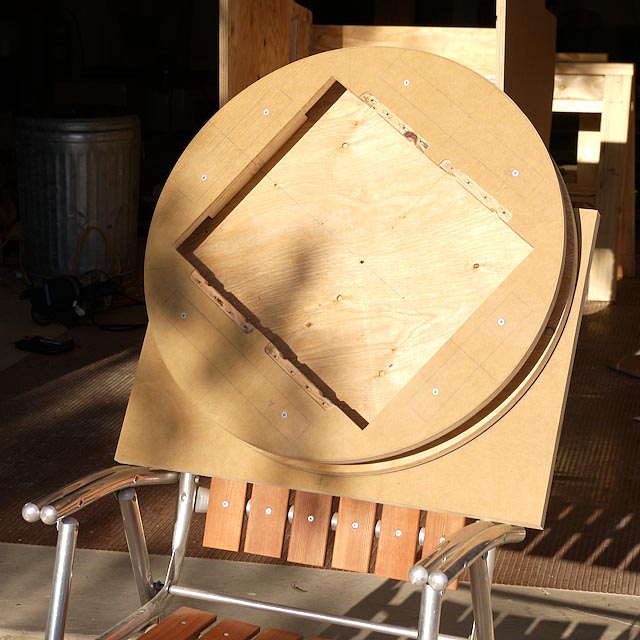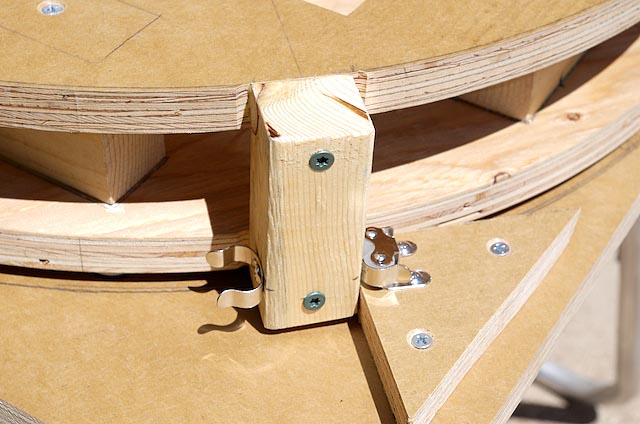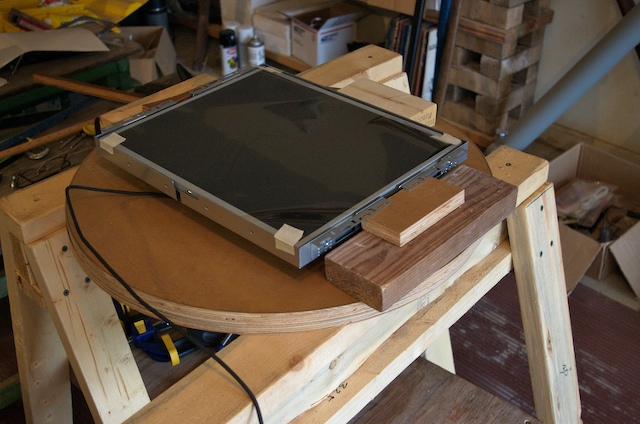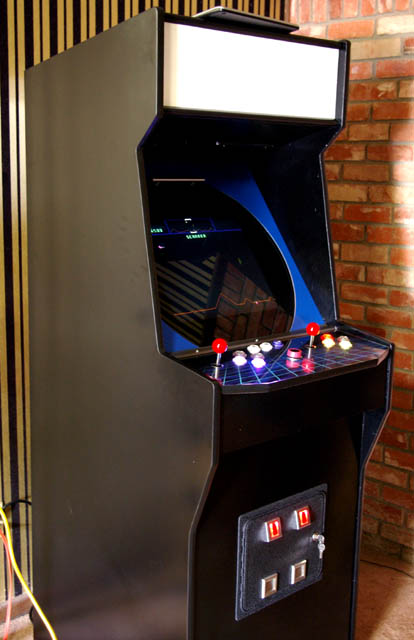I've almost finished my cabinet with a rotating monitor (project thread here:
http://forum.arcadecontrols.com/index.php?topic=78150.0) and figured I should jot down some notes and observations. So. . .
Why rotate? Why not just put a great big monitor in the cabinet, so even the vertical games come out a reasonable size?
That was my first idea. I knew I wanted a LCD, and I didn't like the idea of a widescreen -- especially in a classic-sized cabinet, which was my goal. If I went 4:3 then the biggest I could get was 21-inch, and I'd pay a premium for that. Either way, horizontal games would appear much bigger than vertical games. It nagged at me. So I started thinking about rotation.
My idea was to use a LCD monitor and a lazy susan bearing to create a simple, manually operated rotating mechanism. With LCD there's no huge mass to support, no degaussing problem. The lazy suzan bearing is cheap and readily available. The rest is basic woodworking with a router, which would become familiar to me while building the rest of the cabinet.
I have great admiration for the guys who are doing motorized rigs with custom software to control them. I think what they're doing is amazing. As I followed the threads on their projects, I realized I didn't want to go that way. I wanted to keep it simple, and what they were doing wasn't simple. Also, I don't think any motorized system is likely to be as fast and convenient as a manual system where you just grab the monitor and whang it around into the desired position. It takes about three seconds on my cabinet.
The monitor frame is constructed like a box or cage. There are two circular pieces: one solid, the other one with a cut-out for the monitor. Then there are four 1.5X1.5 spacers between the circular pieces, joining them together. Very early in the design phase I realized I needed both of those circular pieces. One has to go in back to provide a solid connection with the lazy susan bearing and the support board, and the other has to go in front and provide a solid connection for the bezel and handle. It didn't matter whether the monitor was connected to the back circle (with a VESA mount) or the the front circle (with a panel mount). Either way, both pieces would be required for the design to work.

Cutting the circles was done following advice here on BYOAC. I drilled a 1/4" hole in a sheet of 3/4 plywood, then improvised a compass with a small piece of wood and drew the circle. I rough-cut it with a jigsaw. If I didn't care how it looked, I could have left it at that and it would have worked (and the rough edges would have been concealed behind the bezel frame anyhow). To make it pretty I bolted a piece of 1/4" plywood to my router, bolted the other end through the center of the circle, and soon I was trimming a smooth curve.
Making it stop at the vertical and horizontal positions was easy enough, using a couple of roller catches (commonly used with cabinet doors). Magnetic catches would probably have been even easier, as they wouldn't have needed careful alignment.

The monitor I chose was a Happ 19-inch arcade LCD. It uses panel-mounting to the front circle. This monitor has been excellent. The mounting is versatile and clean (you never know if a VESA mount will be centered), it doesn't have any large or off-center frame hanging off the bottom or sides, it comes on whenever power is applied, and the adjustment controls are on a small panel at the end of a cord, so you can place them wherever is convenient. A 19-inch monitor is the same size used by most of the older classic games, so it's authentic in size and aspect ratio.

The bezel is in two parts: the tinted "window" that covers the monitor and rotates with it, and the fixed frame that overlaps around the edges. Both are attached with velcro. So, if I want to access the monitor for any reason, I just remove the control panel, then pull away the bezel frame, then pull away the bezel window, and I'm there. The bezel window itself has two slots allowing it to slip around the handle (an ordinary cabinet or drawer handle, by the way) as it goes on and off.
The bezel is tinted dark gray. This was supposed to improve the black level of the LCD, and it does. It's so dark, I had to crank up the contrast on the LCD and then further adjust the brightness and contrast in my NVidia control panel before I was happy with the look. An advantage of a really dark bezel is that the ugly wood and screws behind it are pretty well hidden. I was going to have some kind of dark material behind it to cover them up, but it turned out to be unnecessary.
The surrounding frame is spray-painted blue. The overall look turns out to be quite retro. It reminds me of 1970s computer equipment, or maybe radar equipment from a control tower. It's perfect for playing Radar Scope.

In the beginning I wanted to use some special switches to keep my front-end synchronized with the screen position. I wanted to have two switches: one to switch the front-end to a horizontal layout, another to switch it to the vertical layout. The switches would be tripped when the monitor rotated past them. I discovered that Mala didn't support this. It only supported a single button to switch between vertical and horizontal layouts. I could install a single switch and have it tripped by the monitor movement -- but I was sure it would get confused and get into situations where it switched the opposite of what was intended.
I then decided to simply set up a button on the control panel and let the user push the button to switch layouts. This turned out to be a great idea. I discovered Mala has an option to automatically switch its layout to match the last game played. So actually it's fairly uncommon that I ever need to push the button. Most of the time it works like this. . .
Let's say I am browsing my list with the monitor horizontal. All the horizontal and vertical games are mixed together in the same list, I don't worry about that when I'm browsing. So I pick, for example, Pac Man. . . The game starts up, and then I suddenly realize everything is sideways on the screen. I reach up to the big handle and whang it around to the vertical position -- takes about three seconds.
When I get tired of Pac Man and exit, Mala automatically switches to vertical layout, and I can continue browsing without having to push any buttons or change the monitor. It's perfectly convenient. I've read comments from a few guys with a rotating monitor rig, who said after the novelty wore off they didn't even rotate it anymore; they just ran everything horizontal because rotating was too much hassle. I can't imagine that ever happening with this cabinet.




 Home
Home Help
Help Search
Search Login
Login Register
Register
 Send this topic
Send this topic Print
Print



